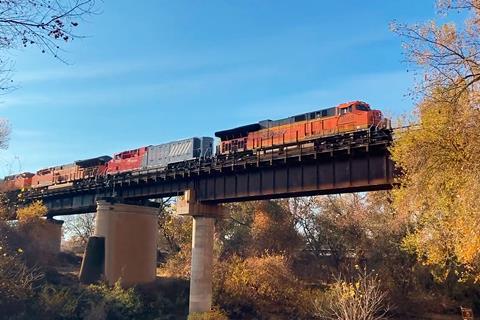
USA: BNSF and Wabtec have begun testing a battery-electric locomotive in revenue service on the 585 km route between Barstow and Stockton in California. The tests aim to assess the future potential of the technology, which as well as the battery features energy-management and system optimisation controls which are designed to improve overall train performance.
‘FLXdrive is the world’s first 100% heavy-haul battery-electric locomotive that optimises the total energy utilisation of the entire locomotive consist’, said Alan Hamilton, Wabtec’s Vice-President, Engineering. ‘This technology works in a manner very similar to how electric vehicles use regenerative braking. It’s a significant step forward for the rail industry and will change the course for even cleaner, more energy-efficient transport.’
The battery-powered locomotive will be operate between two Wabtec Tier 4 diesel locomotives, with the battery-electric and diesel locomotives powering the train in main line use. This is expected to reduce the environmental impact from emissions, and improve fuel economy by at least 10%.
The route being used for testing will subject the locomotive to a variety of operating scenarios, including the comparatively flat route across the San Joaquin Valley and the more difficult mountain route through the Tehachapi Mountains.
There are charging stations at both ends of the test area and at Barstow, where a major BNSF maintenance facility has the capacity to handle any mechanical or electrical issues which might arise.
The pilot testing is scheduled to run from January until the end of March. If it proves successful, BNSF will look to expand testing to other locations and operating conditions.
‘We’ve got everything in place and we’re ready to see how this next-generation locomotive performs in revenue service’, said John Lovenburg, BNSF Vice-President, Environmental. ‘BNSF is focused on continuing to reduce our environmental impact, and we’re committed to doing our part to test and assess the commercial viability of emerging technologies that reduce emissions.’
The pilot programme is being backed with part of a $22·6m grant which the California Air Resource Board awarded to BNSF and the San Joaquin Valley Air Pollution Control District under the Zero and Near Zero-Emission Freight Facilities project, which is supporting several technologies to reduce rail emissions.
This initiative builds on BNSF’s existing investments in technologies including idling control, electric cranes, automated gates at intermodal facilities, the use of battery-electric power for movements in depots, and diesel locomotives meeting Tier 4 emissions standards.

















